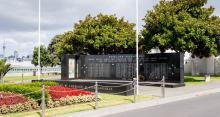Flying from RAF Harrowbeer, in Devon, the Swordfish squadron were tasked to destroy a German torpedo boat, which had been driven ashore by a Canadian destroyer, 2 days previously. 3 Swordfish were shot down in the raid by anti-aircraft fire from the French coast, including the plane flown by Leslie Hayward and one by Ian Wilson. This Fleet Air Arm wing had been assembled on the south coast of England to specifically perform tasks in pre and post D-Day Operations. [For Your Tomorrow, Errol Martyn Vol 2 p 219]
For more than 70 years, Angela Caughey never knew how her brother died.
Late one brisk autumn night in 1944, the postmaster knocked at their Remuera Rd door with a telegram. Her father slowly came back down the hall, his footsteps echoing off the wooden floor.
"It's Ian, girls," he said. Caughey's mother staggered.
Ian Wilson was reported missing, presumed dead, after a Fleet Air Arm operation over occupied France.
It was their second devastating blow of World War II.
Angela was just a schoolgirl when eldest brother Pete Wilson, handsome and dashing in his blue RNZAF pilot's uniform, dropped her off at a friend's house to play.
He leaned across the family's opalescent green DeSoto's front bench seat, kissed her on the cheek, and said, "Be good, Ange."
She never saw him again.
Pete Wilson was killed during a bombing raid over Hamburg.
A third brother, Keith, was advancing on Rome with the New Zealand Division when the second tragedy struck. He was pulled out of the front lines.
Angela Caughey (nee Wilson) says Keith never got over the deaths of his two brothers.
The mysterious death of Sub-Lieutenant Ian Lewis Ruxton Wilson always lingered over the Wilson family.
They have all wondered over the decades, just what happened. How did he die? Was his Swordfish plane shot down? Did he ditch in the North Sea? Was he captured by the Nazis and shot?
But after 72 years, Caughey received a shock phone call from a stranger. It was a conversation that would finally end the family's mystery.
"We never heard another thing from the authorities for 70 years and then suddenly out of the blue last October I received a phone call," said Caughey, now aged 87 and still living in Auckland.
The call came from Napier man, Les Hayward, nephew of Sub-Lieutenant Leslie Frank Hayward, who was a close mate of Wilson's and was shot down on the same mission.
Hayward's nephew, Tony Wiles, had researched the tragedy from his UK home.
His digging led him to Gildas Saouzanet, a local of the Brittany village of Plouguerneau, near Brest, with a passion for uncovering details of World War I and World War II plane crashes in his region of northwest France.
The flight commander's report on the operation suggested the planes went down in a tiny rocky cove on the Brittany coast.
Using a metal detector, Saouzanet was able to discover pieces of fuselage.
It now appears that flight co-ordinates were mistakenly changed mid-flight; Wilson and Hayward were sent to attack a beached German torpedo boat. They were shot down by massed anti-aircraft defences.
Caughey, a "fairly phlegmatic person", admits being stunned by the news.
"I had a good conversation with Les Hayward and got as many details from him as I could," she said.
"I've subsequently got photographs of the unmarked grave where Ian and three others are buried. They didn't want to tell me, but they were burned beyond recognition."
The graves are maintained by the Commonwealth War Graves Commission and Plouguerneau villagers lay flowers to pay their respects.
Now, Caughey and her family will make a pilgrimage to the site in August.
Saouzanet says he will pass on a piece of wreckage from her brother's plane.
"I never expected to find out the whole story," Caughey said.
"It's the sort of thing you never imagine could happen and it's been wonderful. It has brought my brothers into my family's life again."
by Kurt Bayer, NZ Herald 24th April 2017
The "Peter" referred to in the article. is his brother, Warwick Wilson, Kiel War Cemetery.

